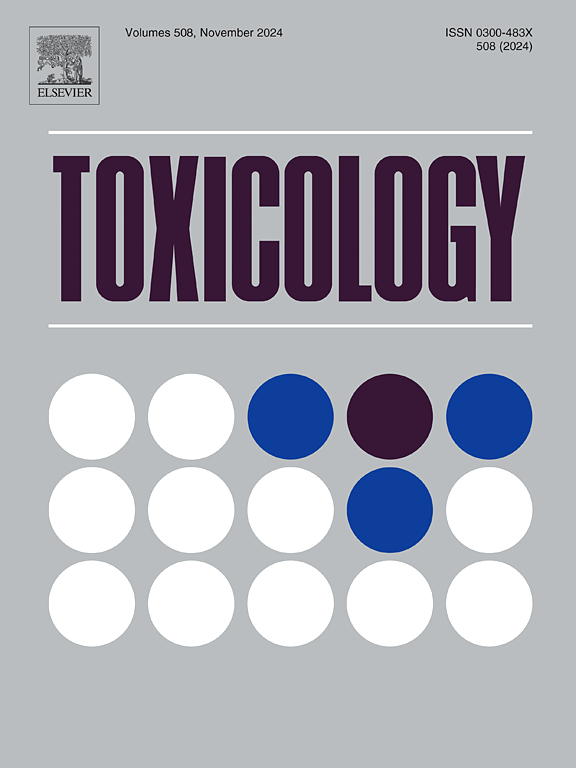暴露于草甘膦除草剂的成年雌性大鼠的神经系统改变:免疫系统的潜在作用。
IF 4.6
3区 医学
Q1 PHARMACOLOGY & PHARMACY
引用次数: 0
摘要
尽管越来越多的证据表明早期接触草甘膦(Gly)和基于草甘膦的除草剂(GlyBHs)对中枢神经系统(CNS)的不良影响,但人们对这种除草剂对发育中的免疫系统的影响知之甚少。我们之前已经描述过,妊娠期和哺乳期大鼠口服GlyBH会导致神经行为改变、大脑氧化应激失衡以及成年期谷氨酸能和胆碱能系统相关酶活性受损。本研究的目的是进一步研究GlyBHs发挥神经毒性的机制,并探讨其对中枢神经系统和免疫系统的影响之间的可能联系。为此,从妊娠第0天到断奶(产后21天),怀孕Wistar大鼠口服暴露于0.4% GlyBH,并对PND90雌性幼崽进行一系列行为和生化分析。血液和血清学参数受到除草剂暴露的影响。此外,GlyBH还改变了围产期暴露大鼠特定脑区乳酸脱氢酶(LDH)活性和氧化还原状态,并减少了海马中星形胶质细胞的数量。最后,glybh治疗诱导抑郁样行为通过强迫游泳测试进行评估。综上所述,本研究的结果表明,在怀孕和哺乳期间暴露于含有甘氨酸的除草剂会导致90天大的雌性后代免疫系统发生长期变化,进而影响它们的中枢神经系统。本文章由计算机程序翻译,如有差异,请以英文原文为准。
Neurological alterations in adult female rats developmentally exposed to a glyphosate-based herbicide: Potential role of the immune system
Despite the increasing evidence about the adverse consequences of early exposure to Glyphosate (Gly) and Gly-based herbicides (GlyBHs) on the central nervous system (CNS), little is known about the effects of this herbicide on the developing immune system. We have previously described that oral exposure of rats to a GlyBH during pregnancy and lactation induces neurobehavioral alterations, brain oxidative stress imbalance, and impairment in the activity of enzymes involved in the glutamatergic and cholinergic systems in adulthood. The purpose of this study was to investigate further the mechanisms of neurotoxicity exerted by GlyBHs and to explore a possible link between their effects on the CNS and the immune system. For this purpose, pregnant Wistar rats were orally exposed to 0.4 % GlyBH from gestational day 0 until weaning (postnatal day (PND) 21), and a series of behavioural and biochemical analyses were conducted in PND90 female pups. Haematological and serological parameters were affected by exposure to the herbicide. In addition, GlyBH altered lactate dehydrogenase (LDH) activity and the redox status in specific brain areas, and decreased the number of astrocytes in the hippocampus of perinatally exposed rats. Finally, GlyBH-treatment induced a depressive-like behaviour evaluated by the forced swim test. Taken together, the findings of the present study demonstrate that exposure to a Gly-containing herbicide during pregnancy and lactation induced long-lasting changes in the immune system of 90-day-old female offspring, which in turn could affect their CNS.
求助全文
通过发布文献求助,成功后即可免费获取论文全文。
去求助
来源期刊

Toxicology
医学-毒理学
CiteScore
7.80
自引率
4.40%
发文量
222
审稿时长
23 days
期刊介绍:
Toxicology is an international, peer-reviewed journal that publishes only the highest quality original scientific research and critical reviews describing hypothesis-based investigations into mechanisms of toxicity associated with exposures to xenobiotic chemicals, particularly as it relates to human health. In this respect "mechanisms" is defined on both the macro (e.g. physiological, biological, kinetic, species, sex, etc.) and molecular (genomic, transcriptomic, metabolic, etc.) scale. Emphasis is placed on findings that identify novel hazards and that can be extrapolated to exposures and mechanisms that are relevant to estimating human risk. Toxicology also publishes brief communications, personal commentaries and opinion articles, as well as concise expert reviews on contemporary topics. All research and review articles published in Toxicology are subject to rigorous peer review. Authors are asked to contact the Editor-in-Chief prior to submitting review articles or commentaries for consideration for publication in Toxicology.
 求助内容:
求助内容: 应助结果提醒方式:
应助结果提醒方式:


